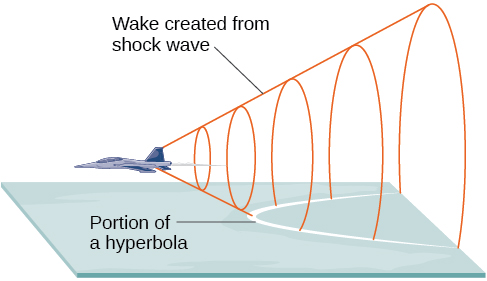
In this section, you will:
What do paths of comets, supersonic booms, ancient Grecian pillars, and natural draft cooling towers have in common? They can all be modeled by the same type of conic. For instance, when something moves faster than the speed of sound, a shock wave in the form of a cone is created. A portion of a conic is formed when the wave intersects the ground, resulting in a sonic boom. See [link].

Most people are familiar with the sonic boom created by supersonic aircraft, but humans were breaking the sound barrier long before the first supersonic flight. The crack of a whip occurs because the tip is exceeding the speed of sound. The bullets shot from many firearms also break the sound barrier, although the bang of the gun usually supersedes the sound of the sonic boom.
In analytic geometry, a hyperbola is a conic section formed by intersecting a right circular cone with a plane at an angle such that both halves of the cone are intersected. This intersection produces two separate unbounded curves that are mirror images of each other. See [link].
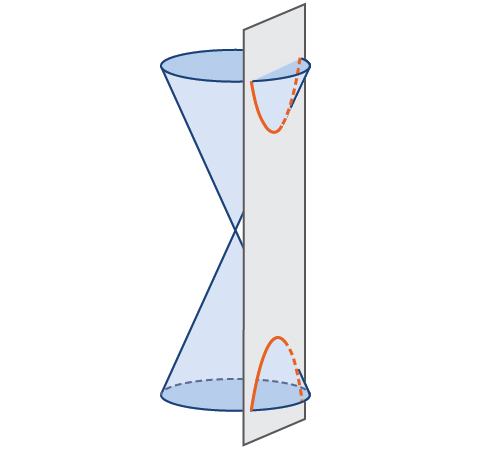
Like the ellipse, the hyperbola can also be defined as a set of points in the coordinate plane. A hyperbola is the set of all points
in a plane such that the difference of the distances between
and the foci is a positive constant.
Notice that the definition of a hyperbola is very similar to that of an ellipse. The distinction is that the hyperbola is defined in terms of the difference of two distances, whereas the ellipse is defined in terms of the sum of two distances.
As with the ellipse, every hyperbola has two axes of symmetry. The transverse axis is a line segment that passes through the center of the hyperbola and has vertices as its endpoints. The foci lie on the line that contains the transverse axis. The conjugate axis is perpendicular to the transverse axis and has the co-vertices as its endpoints. The center of a hyperbola is the midpoint of both the transverse and conjugate axes, where they intersect. Every hyperbola also has two asymptotes that pass through its center. As a hyperbola recedes from the center, its branches approach these asymptotes. The central rectangle of the hyperbola is centered at the origin with sides that pass through each vertex and co-vertex; it is a useful tool for graphing the hyperbola and its asymptotes. To sketch the asymptotes of the hyperbola, simply sketch and extend the diagonals of the central rectangle. See [link].

In this section, we will limit our discussion to hyperbolas that are positioned vertically or horizontally in the coordinate plane; the axes will either lie on or be parallel to the x- and y-axes. We will consider two cases: those that are centered at the origin, and those that are centered at a point other than the origin.
Let
and
be the foci of a hyperbola centered at the origin. The hyperbola is the set of all points
such that the difference of the distances from
to the foci is constant. See [link].
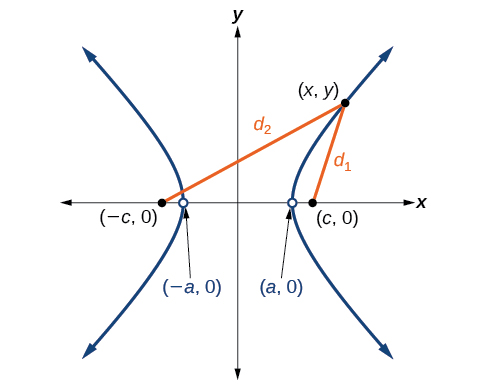
If
is a vertex of the hyperbola, the distance from
to
is
The distance from
to
is
The sum of the distances from the foci to the vertex is
If
is a point on the hyperbola, we can define the following variables:
By definition of a hyperbola,
is constant for any point
on the hyperbola. We know that the difference of these distances is
for the vertex
It follows that
for any point on the hyperbola. As with the derivation of the equation of an ellipse, we will begin by applying the distance formula. The rest of the derivation is algebraic. Compare this derivation with the one from the previous section for ellipses.
This equation defines a hyperbola centered at the origin with vertices
and co-vertices
The standard form of the equation of a hyperbola with center
and transverse axis on the x-axis is
where
where
See [link]a.
The standard form of the equation of a hyperbola with center
and transverse axis on the y-axis is
where
where
See [link]b.
Note that the vertices, co-vertices, and foci are related by the equation
When we are given the equation of a hyperbola, we can use this relationship to identify its vertices and foci.

Given the equation of a hyperbola in standard form, locate its vertices and foci.
is always under the variable with the positive coefficient. So, if you set the other variable equal to zero, you can easily find the intercepts. In the case where the hyperbola is centered at the origin, the intercepts coincide with the vertices.
then the transverse axis lies on the x-axis. The vertices are located at
and the foci are located at
then the transverse axis lies on the y-axis. The vertices are located at
and the foci are located at
using the equation
using the equation
Identify the vertices and foci of the hyperbola with equation
The equation has the form
so the transverse axis lies on the y-axis. The hyperbola is centered at the origin, so the vertices serve as the y-intercepts of the graph. To find the vertices, set
and solve for
The foci are located at
Solving for
Therefore, the vertices are located at
and the foci are located at
Identify the vertices and foci of the hyperbola with equation
Vertices:
Foci:
Just as with ellipses, writing the equation for a hyperbola in standard form allows us to calculate the key features: its center, vertices, co-vertices, foci, asymptotes, and the lengths and positions of the transverse and conjugate axes. Conversely, an equation for a hyperbola can be found given its key features. We begin by finding standard equations for hyperbolas centered at the origin. Then we will turn our attention to finding standard equations for hyperbolas centered at some point other than the origin.
Reviewing the standard forms given for hyperbolas centered at
we see that the vertices, co-vertices, and foci are related by the equation
Note that this equation can also be rewritten as
This relationship is used to write the equation for a hyperbola when given the coordinates of its foci and vertices.
**Given the vertices and foci of a hyperbola centered at
write its equation in standard form.**
and
respectively, then the transverse axis is the x-axis. Use the standard form
and
respectively, then the transverse axis is the y-axis. Use the standard form
using the equation
and
into the standard form of the equation determined in Step 1.
What is the standard form equation of the hyperbola that has vertices
and foci
The vertices and foci are on the x-axis. Thus, the equation for the hyperbola will have the form
The vertices are
so
and
The foci are
so
and
Solving for
we have
Finally, we substitute
and
into the standard form of the equation,
The equation of the hyperbola is
as shown in [link].
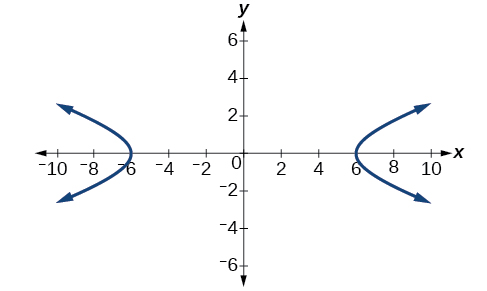
What is the standard form equation of the hyperbola that has vertices
and foci
Like the graphs for other equations, the graph of a hyperbola can be translated. If a hyperbola is translated
units horizontally and
units vertically, the center of the hyperbola will be
This translation results in the standard form of the equation we saw previously, with
replaced by
and
replaced by
The standard form of the equation of a hyperbola with center
and transverse axis parallel to the x-axis is
where
where
The asymptotes of the hyperbola coincide with the diagonals of the central rectangle. The length of the rectangle is
and its width is
The slopes of the diagonals are
and each diagonal passes through the center
Using the point-slope formula, it is simple to show that the equations of the asymptotes are
See [link]a
The standard form of the equation of a hyperbola with center
and transverse axis parallel to the y-axis is
where
where
Using the reasoning above, the equations of the asymptotes are
See [link]b.
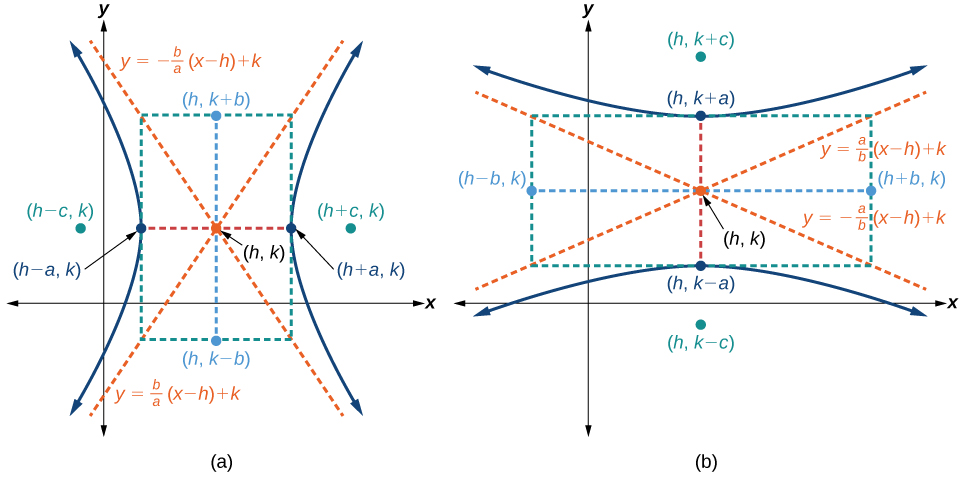
Like hyperbolas centered at the origin, hyperbolas centered at a point
have vertices, co-vertices, and foci that are related by the equation
We can use this relationship along with the midpoint and distance formulas to find the standard equation of a hyperbola when the vertices and foci are given.
**Given the vertices and foci of a hyperbola centered at
write its equation in standard form.**
using the midpoint formula and the given coordinates for the vertices.
by solving for the length of the transverse axis,
, which is the distance between the given vertices.
using
and
found in Step 2 along with the given coordinates for the foci.
using the equation
and
into the standard form of the equation determined in Step 1.
What is the standard form equation of the hyperbola that has vertices at
and
and foci at
and
The y-coordinates of the vertices and foci are the same, so the transverse axis is parallel to the x-axis. Thus, the equation of the hyperbola will have the form
First, we identify the center,
The center is halfway between the vertices
and
Applying the midpoint formula, we have
Next, we find
The length of the transverse axis,
is bounded by the vertices. So, we can find
by finding the distance between the x-coordinates of the vertices.
Now we need to find
The coordinates of the foci are
So
and
We can use the x-coordinate from either of these points to solve for
Using the point
and substituting
Next, solve for
using the equation
Finally, substitute the values found for
and
into the standard form of the equation.
What is the standard form equation of the hyperbola that has vertices
and
and foci
and
When we have an equation in standard form for a hyperbola centered at the origin, we can interpret its parts to identify the key features of its graph: the center, vertices, co-vertices, asymptotes, foci, and lengths and positions of the transverse and conjugate axes. To graph hyperbolas centered at the origin, we use the standard form
for horizontal hyperbolas and the standard form
for vertical hyperbolas.
**Given a standard form equation for a hyperbola centered at
sketch the graph.**
then
then
Graph the hyperbola given by the equation
Identify and label the vertices, co-vertices, foci, and asymptotes.
The standard form that applies to the given equation is
Thus, the transverse axis is on the y-axis
The coordinates of the vertices are
The coordinates of the co-vertices are
The coordinates of the foci are
where
Solving for
we have
Therefore, the coordinates of the foci are
The equations of the asymptotes are
Plot and label the vertices and co-vertices, and then sketch the central rectangle. Sides of the rectangle are parallel to the axes and pass through the vertices and co-vertices. Sketch and extend the diagonals of the central rectangle to show the asymptotes. The central rectangle and asymptotes provide the framework needed to sketch an accurate graph of the hyperbola. Label the foci and asymptotes, and draw a smooth curve to form the hyperbola, as shown in [link].
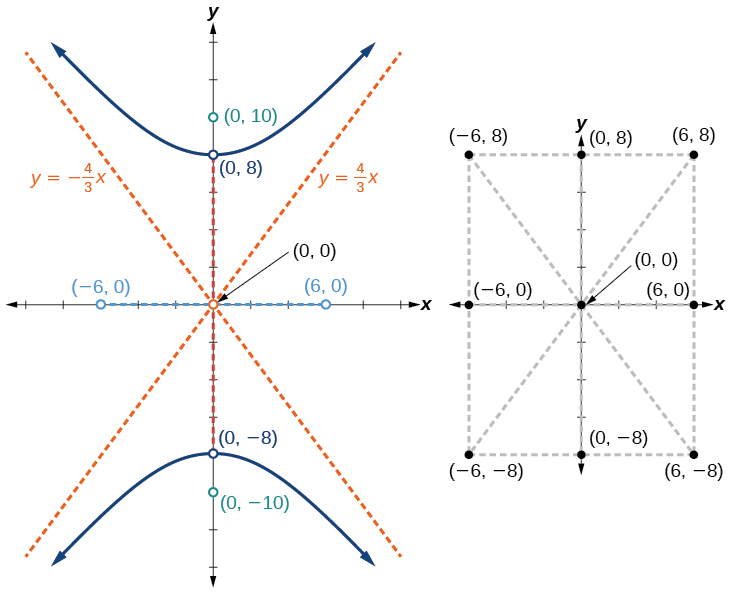
Graph the hyperbola given by the equation
Identify and label the vertices, co-vertices, foci, and asymptotes.
vertices:
co-vertices:
foci:
asymptotes:
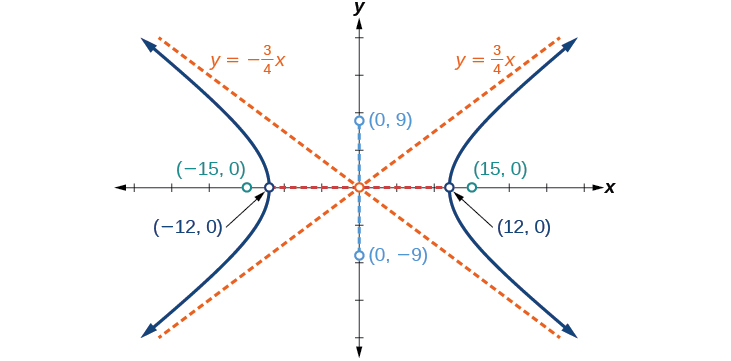
Graphing hyperbolas centered at a point
other than the origin is similar to graphing ellipses centered at a point other than the origin. We use the standard forms
for horizontal hyperbolas, and
for vertical hyperbolas. From these standard form equations we can easily calculate and plot key features of the graph: the coordinates of its center, vertices, co-vertices, and foci; the equations of its asymptotes; and the positions of the transverse and conjugate axes.
**Given a general form for a hyperbola centered at
sketch the graph.**
then
then
Graph the hyperbola given by the equation
Identify and label the center, vertices, co-vertices, foci, and asymptotes.
Start by expressing the equation in standard form. Group terms that contain the same variable, and move the constant to the opposite side of the equation.
Factor the leading coefficient of each expression.
Complete the square twice. Remember to balance the equation by adding the same constants to each side.
Rewrite as perfect squares.
Divide both sides by the constant term to place the equation in standard form.
The standard form that applies to the given equation is
where
and
or
and
Thus, the transverse axis is parallel to the x-axis. It follows that:
or
and
or
and
where
Solving for
we have
Therefore, the coordinates of the foci are
and
The equations of the asymptotes are
Next, we plot and label the center, vertices, co-vertices, foci, and asymptotes and draw smooth curves to form the hyperbola, as shown in [link].

Graph the hyperbola given by the standard form of an equation
Identify and label the center, vertices, co-vertices, foci, and asymptotes.
center:
vertices:
and
co-vertices:
and
foci:
and
asymptotes:
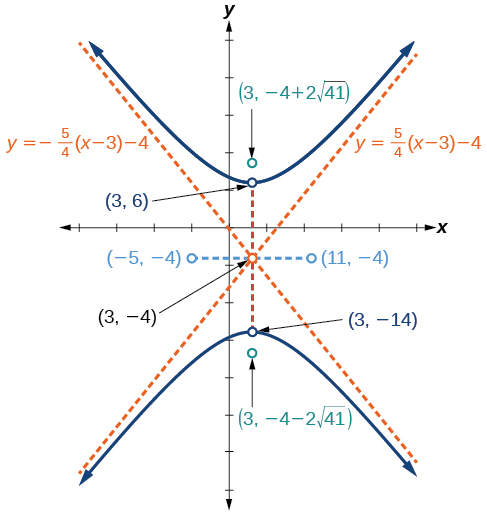
As we discussed at the beginning of this section, hyperbolas have real-world applications in many fields, such as astronomy, physics, engineering, and architecture. The design efficiency of hyperbolic cooling towers is particularly interesting. Cooling towers are used to transfer waste heat to the atmosphere and are often touted for their ability to generate power efficiently. Because of their hyperbolic form, these structures are able to withstand extreme winds while requiring less material than any other forms of their size and strength. See [link]. For example, a 500-foot tower can be made of a reinforced concrete shell only 6 or 8 inches wide!

The first hyperbolic towers were designed in 1914 and were 35 meters high. Today, the tallest cooling towers are in France, standing a remarkable 170 meters tall. In [link] we will use the design layout of a cooling tower to find a hyperbolic equation that models its sides.
The design layout of a cooling tower is shown in [link]. The tower stands 179.6 meters tall. The diameter of the top is 72 meters. At their closest, the sides of the tower are 60 meters apart.
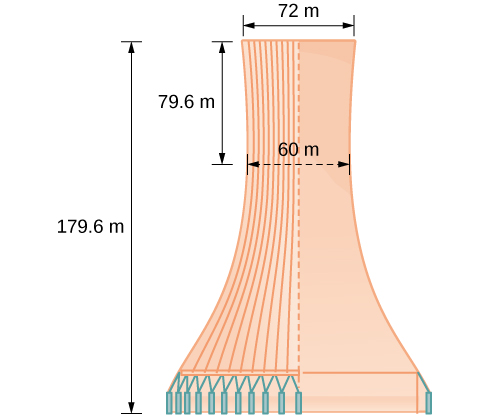
Find the equation of the hyperbola that models the sides of the cooling tower. Assume that the center of the hyperbola—indicated by the intersection of dashed perpendicular lines in the figure—is the origin of the coordinate plane. Round final values to four decimal places.
We are assuming the center of the tower is at the origin, so we can use the standard form of a horizontal hyperbola centered at the origin:
where the branches of the hyperbola form the sides of the cooling tower. We must find the values of
and
to complete the model.
First, we find
Recall that the length of the transverse axis of a hyperbola is
This length is represented by the distance where the sides are closest, which is given as
meters. So,
Therefore,
and
To solve for
we need to substitute for
and
in our equation using a known point. To do this, we can use the dimensions of the tower to find some point
that lies on the hyperbola. We will use the top right corner of the tower to represent that point. Since the y-axis bisects the tower, our x-value can be represented by the radius of the top, or 36 meters. The y-value is represented by the distance from the origin to the top, which is given as 79.6 meters. Therefore,
The sides of the tower can be modeled by the hyperbolic equation
A design for a cooling tower project is shown in [link]. Find the equation of the hyperbola that models the sides of the cooling tower. Assume that the center of the hyperbola—indicated by the intersection of dashed perpendicular lines in the figure—is the origin of the coordinate plane. Round final values to four decimal places.
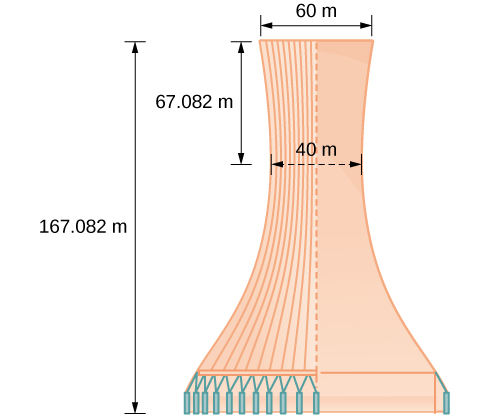
The sides of the tower can be modeled by the hyperbolic equation.
Access these online resources for additional instruction and practice with hyperbolas.
| Hyperbola, center at origin, transverse axis on x-axis |
| Hyperbola, center at origin, transverse axis on y-axis |
| Hyperbola, center at |
| transverse axis parallel to x-axis |
| Hyperbola, center at |
| transverse axis parallel to y-axis |
in a plane such that the difference of the distances between
and the foci is a positive constant.
Define a hyperbola in terms of its foci.
A hyperbola is the set of points in a plane the difference of whose distances from two fixed points (foci) is a positive constant.
What can we conclude about a hyperbola if its asymptotes intersect at the origin?
What must be true of the foci of a hyperbola?
The foci must lie on the transverse axis and be in the interior of the hyperbola.
If the transverse axis of a hyperbola is vertical, what do we know about the graph?
Where must the center of hyperbola be relative to its foci?
The center must be the midpoint of the line segment joining the foci.
For the following exercises, determine whether the following equations represent hyperbolas. If so, write in standard form.
yes
yes
For the following exercises, write the equation for the hyperbola in standard form if it is not already, and identify the vertices and foci, and write equations of asymptotes.
vertices:
foci:
asymptotes:
vertices:
foci:
asymptotes:
vertices:
foci:
asymptotes:
vertices:
foci:
asymptotes:
vertices:
foci:
asymptotes:
vertices:
foci:
asymptotes:
vertices:
foci:
asymptotes:
vertices:
foci:
asymptotes:
For the following exercises, find the equations of the asymptotes for each hyperbola.
For the following exercises, sketch a graph of the hyperbola, labeling vertices and foci.
For the following exercises, given information about the graph of the hyperbola, find its equation.
Vertices at
and
and one focus at
Vertices at
and
and one focus at
Vertices at
and
and one focus at
Center:
vertex:
one focus:
Center:
vertex:
one focus:
Center:
vertex:
one focus:
For the following exercises, given the graph of the hyperbola, find its equation.
For the following exercises, express the equation for the hyperbola as two functions, with
as a function of
Express as simply as possible. Use a graphing calculator to sketch the graph of the two functions on the same axes.
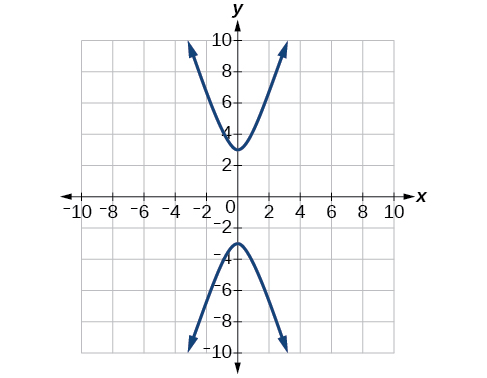

For the following exercises, a hedge is to be constructed in the shape of a hyperbola near a fountain at the center of the yard. Find the equation of the hyperbola and sketch the graph.
The hedge will follow the asymptotes
and its closest distance to the center fountain is 5 yards.

The hedge will follow the asymptotes
and its closest distance to the center fountain is 6 yards.
The hedge will follow the asymptotes
and
and its closest distance to the center fountain is 10 yards.

The hedge will follow the asymptotes
and
and its closest distance to the center fountain is 12 yards.
The hedge will follow the asymptotes
and its closest distance to the center fountain is 20 yards.

For the following exercises, assume an object enters our solar system and we want to graph its path on a coordinate system with the sun at the origin and the x-axis as the axis of symmetry for the object's path. Give the equation of the flight path of each object using the given information.
The object enters along a path approximated by the line
and passes within 1 au (astronomical unit) of the sun at its closest approach, so that the sun is one focus of the hyperbola. It then departs the solar system along a path approximated by the line
The object enters along a path approximated by the line
and passes within 0.5 au of the sun at its closest approach, so the sun is one focus of the hyperbola. It then departs the solar system along a path approximated by the line
The object enters along a path approximated by the line
and passes within 1 au of the sun at its closest approach, so the sun is one focus of the hyperbola. It then departs the solar system along a path approximated by the line
The object enters along a path approximated by the line
and passes within 1 au of the sun at its closest approach, so the sun is one focus of the hyperbola. It then departs the solar system along a path approximated by the line
The object enters along a path approximated by the line
and passes within 1 au of the sun at its closest approach, so the sun is one focus of the hyperbola. It then departs the solar system along a path approximated by the line
in a plane such that the difference of the distances between
and the foci is a positive constant

You can also download for free at http://cnx.org/contents/13ac107a-f15f-49d2-97e8-60ab2e3b519c@11.1
Attribution: